Norman Franke – 7 November, 2024
There is not a single work that could not have been mentioned in this review, and which is not a great achievement in its own right. I share this impression with friends who have visited the show: the energy, skill, perseverance and courage that is on display in 'Something in Common' is remarkable and it is discernable in every single work.
Hamilton
Something in Common
Arts for Health annual exhibition
1 November to 1 December 2024.
One of the most interesting, thought-provoking and inspiring annual exhibitions of the Waikato arts calendar has to be the Arts for Health show at Hamilton’s Artspost. For 37 years, Arts for Health has run arts classes and exhibitions for vulnerable and disadvantaged people, but their Frankton based art classes and workshops are open to everyone in the community. Their exhibitions and competitions ‘have been tapping into the power of creativity to support Hamilton’s mental health and overall well-being’ by firing the imagination of local artists and art lovers of all ages and backgrounds. Arts for Health (https://www.artsforhealth.co.nz/) is one of those amazing community-building projects that remains a beacon of hope and social cohesion in times of great political, economic and environmental dangers.
This year’s exhibition is entitled Something in Common and showcases more than a hundred art works all of which are for sale. The annual exhibition is one of the main fund-raising events for Arts for Health. There is a wide range of media and genres, including oil and acrylic paintings, watercolours, pen and ink drawings, pastels, multi-media collages and sculptures. Since its very beginning, art has had a variety of functions: celebrating beauty, finding meaning, transcending the confinements of physical, mental and social restrictions, critiquing or satirising politics, creating therapeutic spaces and those of creativity, co-productivity and friendship, to name just a few. All of these are present in Something in Common; often many are simultaneously present in the art works.
As it is impossible to do justice to the enormous breadth and width of the exhibition in a brief review, I would like to highlight just a few works that particularly attracted my attention. But not without first submitting that there is not a single work that could not have been mentioned in this review, and which is not a great achievement in its own right. I share this impression with friends who have visited the show: the energy, skill, perseverance and courage that is on display in Something in Common is remarkable and it is discernable in every single work.
****
Darling Meihana’s flower painting Colourful Love (acrylic on canvas) impresses with its skillful lay-out and colour schemes. It is also a succinct depiction of the exhibition’s title. In light of old symbolic interpretations of flowers, which in Meihana’s paintings are of different sizes and sometimes not yet completely developed and in full bloom, the flowers can perhaps also be interpreted as an allegory of the progress and flourishing of people. All strife to face the sun and together form a colourful ecosystem of friendly coexistence. Viewing the painting, I felt reminded of a saying by Nâzım Hikmet (slightly adopted to the flowers here, Hikmet actually refers to trees): ‘To live like a flower, individually and free, yet solidarious like a wildflower meadow, that is our longing’.
Ricki McInman’s sophisticated enamel board Petroglyph Star People depicts a range of celestial bodies, cosmological forces and movements, and a stylised human person interacting with these universal energies. The arrangement is reminiscent of old alchemical tableaux in the wake of Robert Fludd or Jacob Böhme who pointed out that the cosmogenetic development eventually evolves into human beings in order to reflect itself in their art and world views. An idea that also appears in modern versions of Heisenberg’s uncertainty theories. Thus the petroglyphic (from Ancient Greek petra “rock” + glyphē “carving”) dimension of art may be traced back to pre-historic times when matter solidified into stars and rock formations.
Harrison Forlong’s charming painting Palace of Vienna in Austria (acrylic and pen on canvas) can be both read as a souvenir of the Austrian capital and as a reflection on architecture and power. Following the proportions of the Golden Ratio, the image is roughly divided into two distinct spaces. The upper part of the painting shows the Hofburg (Palace of Vienna) the lower part the vast empty parade ground in front of the palace and the head of a horse. Slightly bent and almost smiling, the horse’s features juxtapose the grandeur of the palace. They remind the viewer that imperial power would not have been possible without the power of the humble horse. And that even in the 21st century, the world’s big cities are not solely a human habitat. Horse drawn taxis or Fiaker are still a feature of Vienna’s traffic today.
A huge stylised elephant stands in the centre of a slightly surrealist landscape in Aditya Ramesh’s painting Joyful Memories. Painted in acrylic in an impasto style, the animal stands out against the red tones of a desert landscape and the night sky. The colours of the animal’s body, especially in the area around the eye, correspond to a shining star just above the horizon. The charismatic elephant, the largest land mammal on earth, is presented in all its strength and vulnerability. There is another moving depiction of elephants in this exhibition in Maria Spanbroek’s work Connection is Good.
Oliver Stewart’s Pharyngeal Jaw appeals to the viewers’ imagination. Is it a satellite image of a water town? A cross-section through a plant cell? Or a stylised anatomical representation of a fish’s mouth? The overall triad of red, blue and yellow forms many intricate puzzles. But regardless of a factual explanation, the image provides a pleasing arrangement of inter-relating colours and surfaces.
Arlo Cathcart’s acrylic study Christiano Siuuu shows the short gravity defying moment of an overhead kick in soccer. Pure concentration and body control have congealed into an airborne moment of unusual but perfect posture. And yet the picture radiates a lightness and elegance, which is further underlined by the colour palette of simple complementary tones of sky-blue and pitch-green. The picture’s composition, too, is remarkable: The soccer player’s straight back hovers on the line of the horizon where earth and sky meet.
Voice from the Cloud is the title of a text-based painting by Gerard Guzzo. The medium size canvas displays the prefix ‘un’ in oversize letters which dominates words half its size like ‘successful’, ‘desirable’, ‘impressive’, andd ‘lovable’. Read together the prefix and smaller words form the negatives: ‘unsuccessful’, ‘undesirable’, ‘unimpressive’, ‘unlovable’. The painting thus challenges the viewer to reflect on social norms and values: Who in society, in groups and relationships actually decides who or what is (un-)successful, (un-)impressive, or (un-)lovable? In Neoliberal times, who is entitled to promote or reject people, lifestyles, art works and ideas? The bosses, the managers, the psychologists or scientists, the ‘invisible hand of the market’?
The painting’s title seems to also provide the viewer with additional questions or clues: Is the ‘Cloud’ the internet data reservoir, the anonymous storage of all postmodern ideas and texts? Or is it the old mythological metaphor for the heavens?
Norman Franke
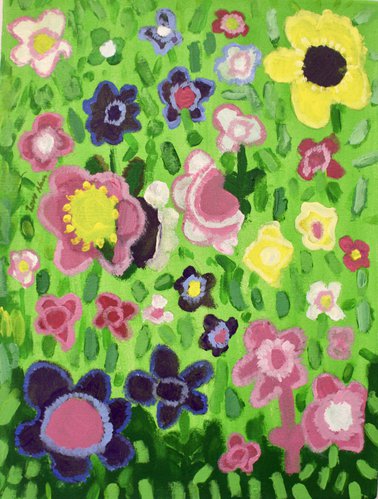
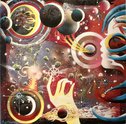
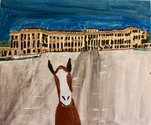
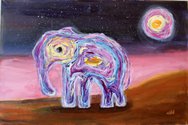


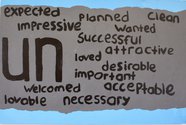

 Advertising in this column
Advertising in this column Two Rooms presents a program of residencies and projects
Two Rooms presents a program of residencies and projects

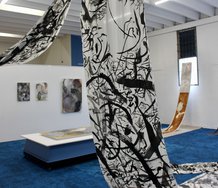
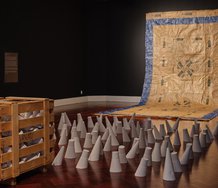
This Discussion has 0 comments.
Comment
Participate
Register to Participate.
Sign in
Sign in to an existing account.